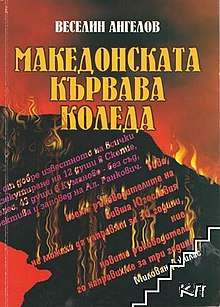Bloody Christmas (1945)
The Bloody Christmas (Bulgarian: Кървава Коледа, Kărvava Koleda; Macedonian: Крвава Коледа, Krvava Koleda) or the Bloody Bozhik (Bulgarian: Кървав Божик, Kărvav Bozhik; Macedonian: Крвав Божиќ, Krvav Božiḱ) was a campaign in which several hundred people of Macedonian Bulgarian descent were killed as collaborationists by the Yugoslav communist authorities in the Yugoslav Republic of Macedonia between 7–9 January 1945.[1] Thousands of others who retained their pro-Bulgarian sympathies suffered severe repression as a result.[2]

| Part of a series on |
| Aftermath of World War II in Yugoslavia |
|---|
| Main events |
|
| Massacres |
| Camps |
After the end of the Second World War, manifested Bulgarians in the so-called "new lands" in Vardar Macedonia, briefly annexed to Bulgaria during the war, were persecuted with the heavy charges of "great-Bulgarian chauvinism". This chapter of the Macedonia's history was a taboo subject for conversation until the late 1980s, and as a result, decades of official silence created a reaction in the form of numerous data manipulations for nationalist, communist propaganda purposes.[3][4] To wipe out the bulgarophile sentiments of parts of the local population, the Yugoslav Communists started a remarkable process of nation-building.[5]
From the start of the new SR Macedonia, accusations surfaced that new authorities were involved in retribution against people who did not support the formation of the new Ethnic Macedonian identity.[6] The number of dead "traitors" and "collaborators" due to organized killings of Bulgarians during the Bloody Christmas and afterwards, however is unclear, but some sources put the number of the victims to 1,200.[7]
The idea was to weaken the Bulgarian intelligentsia in Macedonia, to eradicate the Bulgarian self-consciousness of parts of the population and to speed-up the process of Macedonisation.[8]
During the terror of January 1945, on the road between Lake Ohrid and Lake Prespa, and on the hills of Galičica mountain near the village of Oteševo and other villages, more Bulgarians were executed.[9] Most of the bodies were disposed of in the Prespa lake. Nearly all inhabited places in Vardar Macedonia provided victims for the campaign.[10] In several cities in Vardar Macedonia which were set up people's courts, issuing death sentences over citizens charged of "great-Bulgarian chauvinism". Only in Skopje, in 1945, 18 trials were held with 226 defendants, 22 of whom were sentenced to death. In Štip in the same period seven Bulgarians were sentenced to death, in Prilep - ten, in Veles - ten, in Bitola - nine.[11]
According to Bulgarian sources, between 1945-47 over 4,700 Bulgarians were massacred or went missing.[12] As a result of the purge, up to 100,000 people were deported, displaced, imprisoned, persecuted or sent to concentration camps of the former Yugoslavia.[13][14]
See also
- Macedonian nationalism
- Macedonian Bulgarians
- Bulgarians in the Republic of Macedonia
Notes
- Historical Dictionary of the Republic of Macedonia by Dimitar Bechev, Scarecrow Press, 2009; ISBN 0810855658, p. 287.
- Who Are the Macedonians? by Hugh Poulton, C. Hurst & Co. Publishers, 2000; ISBN 1850655340, p. 118.
- Contested Ethnic Identity: The Case of Macedonian Immigrants in Toronto, 1900-1996 by Chris Kostov, Peter Lang (publisher), 2010; ISBN 3034301960, p. 84.
- Thinking About Yugoslavia: Scholarly Debates About the Yugoslav Breakup and the Wars in Bosnia and Kosovo by Sabrina P. Ramet, Cambridge University Press, 2005; ISBN 0521616905, p. 281.
- Nikolaos Zahariadis, Essence of political manipulation: emotion, institutions, & Greek foreign policy, Peter Lang (publisher), 2005; ISBN 0820479039, p. 85.
- Djokić, Dejan (2003). Yugoslavism: Histories of a Failed Idea, 1918-1992, C. Hurst & Co. Publishers (pg. 122); ISBN 1-85065-663-0.
- Macedonia: Warlords and Rebels in the Balkans by John Phillips, I.B. Tauris (publisher), 2004; ISBN 186064841X, p. 40.
- Мичев, Д. Македонският въпрос и българо-югославските отношения 1944-1949 г. Университетско издателство "Свети Климент Охридски", София, 1994 г. стр. 80-82.
- Македонизмът и съпротивата на Македония срещу него Коста Църнушанов, Университетско издателство "Свети Климент Охридски", София, 1992 г.; глава. 25. и гл. 26.
- Angelov, Veselin. Macedonian Bloody Christmas, Galik Publishing House, Sofia 2003, ISBN 9548008777, pp. 179-201.
- Цанко Серафимов, Енциклопедичен речник за Македония и македонските работи, Орбел, 2004, стр. 298.
- Новата национално-освободителна борба във Вардарска Македония 1944-1991 г. Димитър Гоцев, Македонски научен институт, София, 1998 г. гл. 3.
- State Identities and the Homogenisation of Peoples by Heather Rae, Cambridge University Press, 2002; ISBN 052179708X, p. 227.
- Additionally, some 100,000 people were imprisoned in the post-1944 period for violations of the law for the "protection of Macedonian national honor," and some 1,260 Bulgarian sympathizers were allegedly killed. (Troebst, 1997: 248-50, 255-57; 1994: 116-22; Poulton, 2000: 118-19). For more see: Roudometof, Victor, Collective Memory, National Identity, and Ethnic Conflict: Greece, Bulgaria, and the Macedonian Question, Praeger Publishers, 2002. ISBN 0-275-97648-3, p. 104.
External links
- Statistics of Yugoslavia's Democide. Estimates, calculations, and sources by R.J. Rummel.